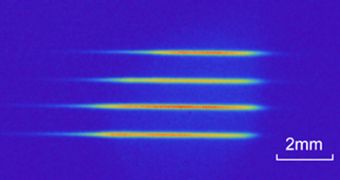A team of physicists in the United States managed recently to show that it is possible to apply quantum entanglement to four spatially distinct atomic memories, that store a single quantum state.
The researchers also showed that a quantum interface existed between the atomic memories and four beams of light. In other words, it appears that this four-fold entanglement can be transmitted through quantum networks via photons, the basic particles of light.
The atomic memories were connected in a way that made them resemble a computer hard disk drive, which means that the work clears the way for a more thorough investigation into constructing quantum memories.
These components are required in order to allow for the construction of a quantum computer, a machine that would make good use of the laws of quantum mechanics to enable faster processors, memories and so on.
Investigators from the California Institute of Technology (Caltech), in Pasadena, California conducted the investigation, which is detailed in the November 18 issue of the esteemed scientific journal Nature.
One of the major implications of this study is that it extended the amount of coherent control that physicists can exert on the quantum entanglement of spatially separated physical systems containing matter and light.
The team that demonstrated this proof-of-principle was led by the Caltech William L. Valentine Professor and professor of physics H. Jeff Kimble, who believes that the research could pave the way for new and advanced quantum networks.
“Our work introduces new sets of experimental capabilities to generate, store, and transfer multipartite entanglement from matter to light in quantum networks,” explains Kyung Soo Choi, who is the lead author of the Nature paper.
“It signifies the ever-increasing degree of exquisite quantum control to study and manipulate entangled states of matter and light,” adds the expert, who is also a Caltech graduate student.
“In the zoology of entangled states, our experiment illustrates how multipartite entangled spin waves can evolve into various subsets of the entangled systems over time, and sheds light on the intricacy and fragility of quantum entanglement in open quantum systems,” he adds further.
The new work was sponsored with grant money provided by the US National Science Foundation (NSF), the National Security Science and Engineering Faculty Fellowship program of the Department of Defense (DOD), the Northrop Grumman Corporation, and the Intelligence Advanced Research Projects Activity.

 14 DAY TRIAL //
14 DAY TRIAL //